
This page (Page #9)
has creative activities for use in the classroom. Kids love to
learn more about the play’s origin and subject. Check out
these articles and activities related to ArtReach’s popular titles: Robin
Hood, Sword in the Stone, Snow
White, Treasure Island, The
Legend of Sleepy Hollow, Winnie the Pooh, The
Little Mermaid, A
Thousand Cranes, Amelia
Earhart, Cinderella, Twas the Night
Before Christmas. Don’t
forget, a Teachers Guide will come with your School Play Package and
contains tons of creative new ideas for your teaching lessons!

ArtReach's
Robin Hood - Takes from the rich and gives to the poor!
Synopsis
of the ArtReach
Play for Young Audiences
With
King Richard the Lionhearted away fighting wars in the Holy Land,
his brother Prince John seizes the regency in England. Prince John
and his followers are hard on the peasants, increasing their taxes
and hanging those that cannot afford to pay. Robin of Locksley, also
known as Robin Hood, rebels against the prince and is declared an
outlaw. Living in Sherwood Forest, Robin and the Merry Men rob from
the rich, give to the poor. Despite their dedication to avenging the
less fortunate, Robin still takes time to woo the lovely Maid Marian,
who has been promised to Prince John by her father the Sheriff. She
actively resists the force of her father and the prince and later
joins the Merry Men.
"Robin
Hood rebels against the prince and is declared an outlaw."
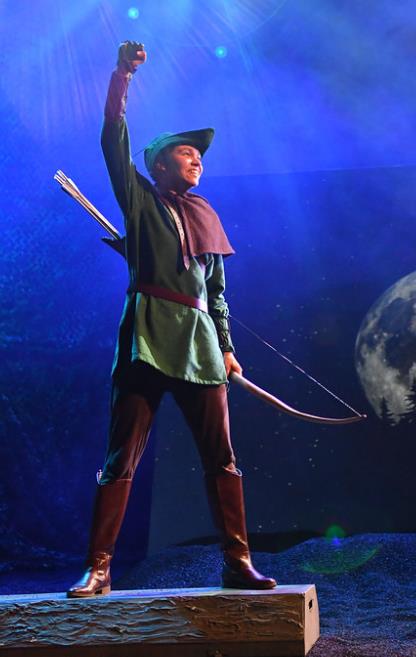

ArtReach's Robin
Hood - The English Theatre, Frankfurt Germany
The
Characters
Robin
Hood steals from the rich to give to the poor and is the best archer
all around. Robin appears in many disguises and operates right under
the Prince´s nose as Beggar or Jester.
Little
John meets Robin Hood in Sherwood Forest and joins the Merry Men.
Maid
Marian, daughter of the Sheriff of Nottingham, is supposed to marry
Prince John. However, she has other plans and resists her father actively.
Prince
John took charge when King Richard left and rules with an iron fist,
suppressing his subjects and constantly raising taxes. He doesn't
care for the poor but only for his wealth. He wants to marry Maid Marian.
The
Sheriff of Nottingham is Prince John´s right hand and the
father of Maid Marian.
"King
Richard is supported by Robin Hood & the Merry Men."

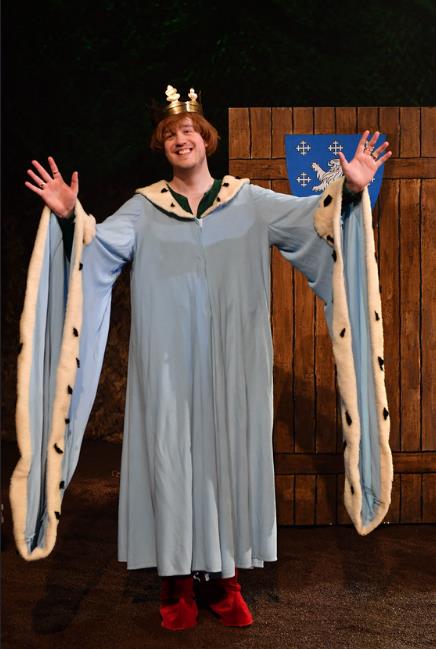
ArtReach's Robin
Hood - The English Theatre, Frankfurt Germany
Friar
Tuck is a sly food-loving churchman and part of the Merry Men of
Sherwood Forest. Being also a confidant of Prince John, he can
provide Robin Hood with information about the Prince´s plans and whereabouts.
King
Richard is the true ruler but away fighting wars. It is unclear
whether he will ever return. He is supported by Robin Hood and the
Merry Men.
Robin
Hood
The
legend Robin Hood, legendary outlaw hero of a series of English
ballads, some of which date from at least as early as the 14th
century. Robin Hood was a rebel, and many of the most striking
episodes in the tales about him show him and his companions robbing
and killing representatives of authority and giving the gains to the
poor. Their most frequent enemy was the Sheriff of Nottingham, a
local agent of the central government (though internal evidence from
the early ballads makes it clear that the action took place chiefly
in south Yorkshire, not in Nottinghamshire). Other enemies included
wealthy ecclesiastical landowners. Robin treated women, the poor, and
people of humble status with courtesy. A good deal of the impetus for
his revolt against authority stemmed from popular resentment over
those laws of the forest that restricted hunting rights. The early
ballads, especially, reveal the cruelty that was an inescapable part
of medieval life.
"The
play takes a closer look at the man from Sherwood Forest."

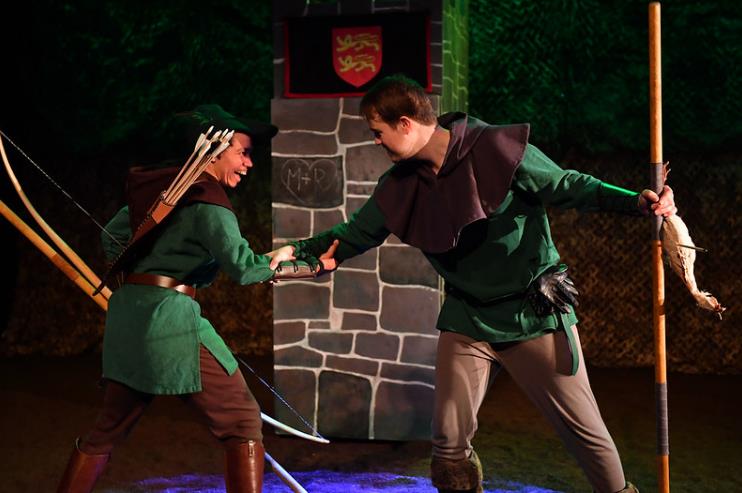
ArtReach's Robin
Hood - The English Theatre, Frankfurt Germany
Numerous
attempts have been made to prove that there was a historical Robin
Hood, though references to the legend by medieval writers make it
clear that the ballads themselves were the only evidence for his
existence available to them. A popular modern belief that he was of
the time of Richard I probably stems from a "pedigree"
fabricated by an 18th-century antiquary, William Stukeley. None of
the various claims identifying Robin Hood with a particular
historical figure has gained much support, and the outlaw's existence
may never have been anything but legendary. The authentic Robin Hood
ballads were the poetic expression of popular aspirations in the
north of England during a turbulent era of baronial rebellions and
agrarian discontent, which culminated in the Peasants' Revolt of
1381. The theme of the free but persecuted outlaw enjoying the
forbidden hunting of the forest and outwitting or killing the forces
of law and order naturally appealed to the common people.
Although
many of the best-known Robin Hood ballads are postmedieval, there is
a core that can be confidently attributed to the medieval period.
These are Robin Hood and the Monk, Robin Hood and Guy of Gisborne,
Robin Hood and the Potter, and the Lytyll Geste of Robin Hode. During
the 16th century and later, the essential character of the legend was
distorted by a suggestion that Robin was a fallen nobleman, and
playwrights, eagerly adopting this new element, increased the
romantic appeal of the stories but deprived them of their social
bite. Postmedieval ballads (which gave Robin a companion, Maid
Marian) also lost most of their vitality and poetic value, doubtless
as a result of losing the original social impulse that brought them
into existence.
"Robin
Hood embodies dreams of social justice."

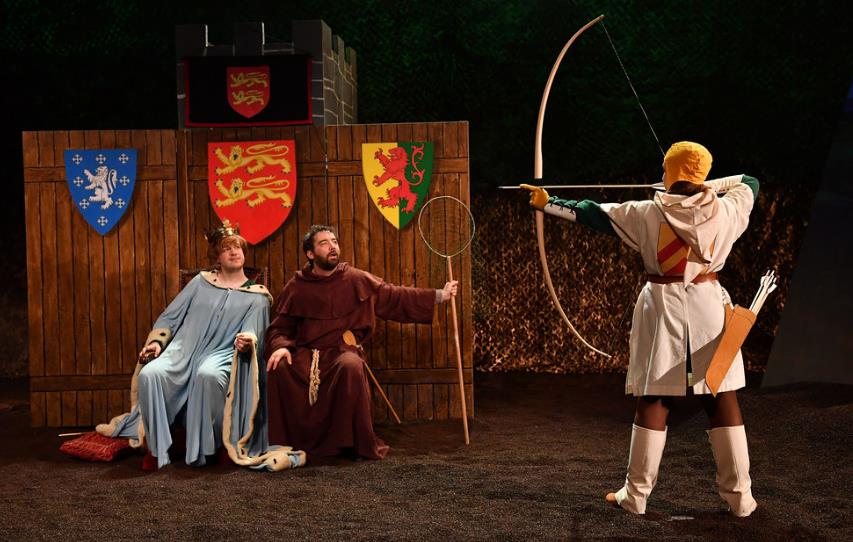
ArtReach's Robin
Hood - The English Theatre, Frankfurt Germany
Robin
Hood - the
hero for everyone Robin Hood, as the centuries have shown, is an
ideal identification figure and a political as well as literary
figure. As Judith Klinger, Potsdam medievalist, points out, Robin
Hood embodies dreams of social justice, of life in nature, of
community and of "heroic resistance" - against whatever.
Robin is so powerful because he helps people build castles in the air
and escape in their minds from an unjust society full of constraints.
Sometimes
Robin appears as a predatory individualist, sometimes as a merry
adventurer, sometimes as a disinherited nobleman. He is knight,
businessman, courtier, patriot and social revolutionary. Sometimes he
rebels against society, sometimes he is system-stabilizing. Most of
the time he remains a loyal royalist, but is nevertheless an integral
part of the socio-political vocabulary of the Left Party. And
occasionally he comes across as a modernization loser who unabashedly
robs those who have surpassed him of their possessions. Robin Hood is
reinterpreted from epoch to epoch, and anyone who takes a closer look
at the man from Sherwood Forest - depending on the play, novel or
film - will glimpse the respective zeitgeist.

There
Be Dragons - in ArtReach's Plays
History of Dragons
A
dragon is a legendary or mythical creature that resembles a large
lizard or snake. Dragons are often portrayed as having scaly skin, a
powerful jaw with sharp teeth, four legs with long claws, and a long
tail. In medieval Europe dragons were usually depicted as having
wings and breathing fire, while in Japan dragons were large sea
serpents without wings. In some stories dragons are good, and in
others they are evil.
Dragons
in ArtReach's Sword in the Stone
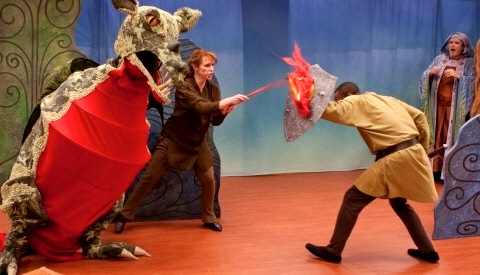
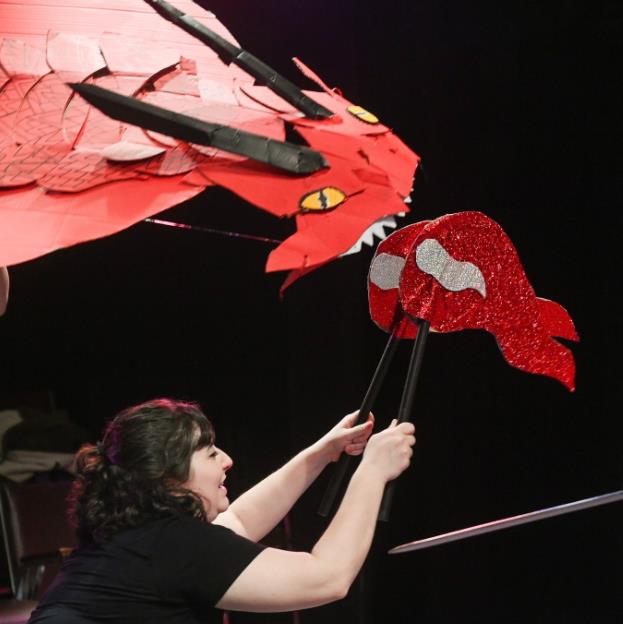
Repertory Theatre of St. Louis The
Heights Players, Brooklyn, NY
Legends of
dragons have been in existence since ancient times. Scholars,
however, do not know exactly how or when the dragon first entered
into people’s stories. Some researchers speculate that people
formed superstitions after finding bones from the dinosaurs that
roamed the prehistoric world. These giant creatures, as well as some
reptiles of great size that lived at the same time as the first
humans, may have given rise to legends of monsters such as dragons.
In many
Western myths, such as in Europe, the serpent or dragon was mostly
symbolic of evil. This portrayal may have developed in the Middle
East, where snakes are large and deadly. The Greeks and Romans
accepted this idea of the serpent as an evil power but at times also
thought of dragons as good. In general, however, the evil reputation
of dragons was stronger. In Christianity the dragon came to be
symbolic of sin and paganism (non-Christian beliefs). Legends dating
from the early Middle Ages portray Saint George, the patron saint of
England, as a warrior-saint. One story has him rescuing a Libyan
king’s daughter from a dragon and then slaying the monster. In
return the king’s subjects promised to be baptized.
Dragons
in ArtReach's The Legend of Mulan
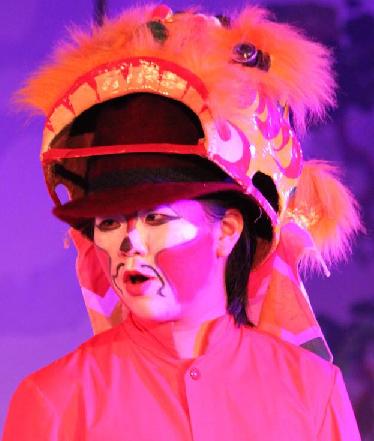
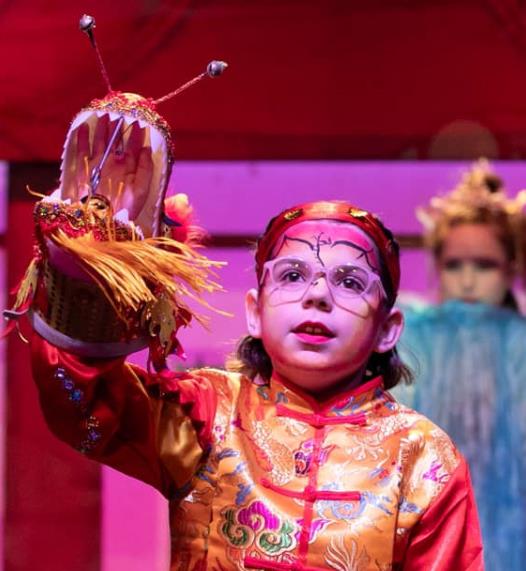
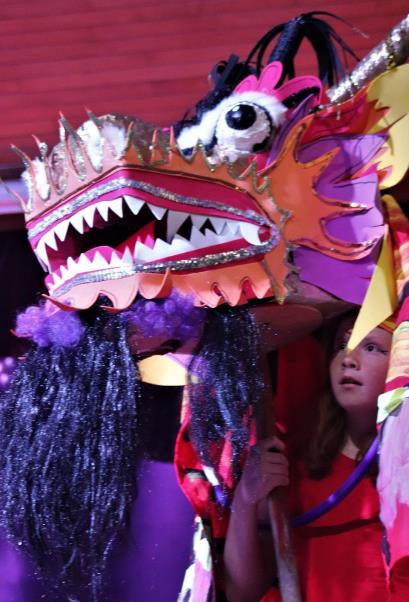
Island School HI - Seoul
Foreign School, South Korea - Fish Hoek Primay School, Cape Town SA
Because people viewed dragons
as both protective and fearsome, they were used as warlike emblems.
For example, King Agamemnon from Homer’s Iliad had a blue
three-headed snake on his shield. Norse warriors often painted
dragons on their shields and carved dragon heads on the bows of their
ships. In England before ad 1000 a dragon flag was among the royal
flags used in war. In the 20th century the dragon was officially
incorporated in the coat of arms of the prince of Wales.
In most Eastern myths,
including those from China and Japan, the dragon is a charitable and
knowledgeable creature that wards off evil. From ancient times the
Chinese dragon was the emblem of the imperial family and for years
adorned the Chinese flag. In Japan the dragon was thought to be
capable of changing its size at will, even to the point of becoming
invisible. Dragons also figure in the ancient mythologies of other
Asian cultures, including those of Korea, India, and Vietnam.
Theatre
Dragons in ArtReach Plays - Sword in the Stone
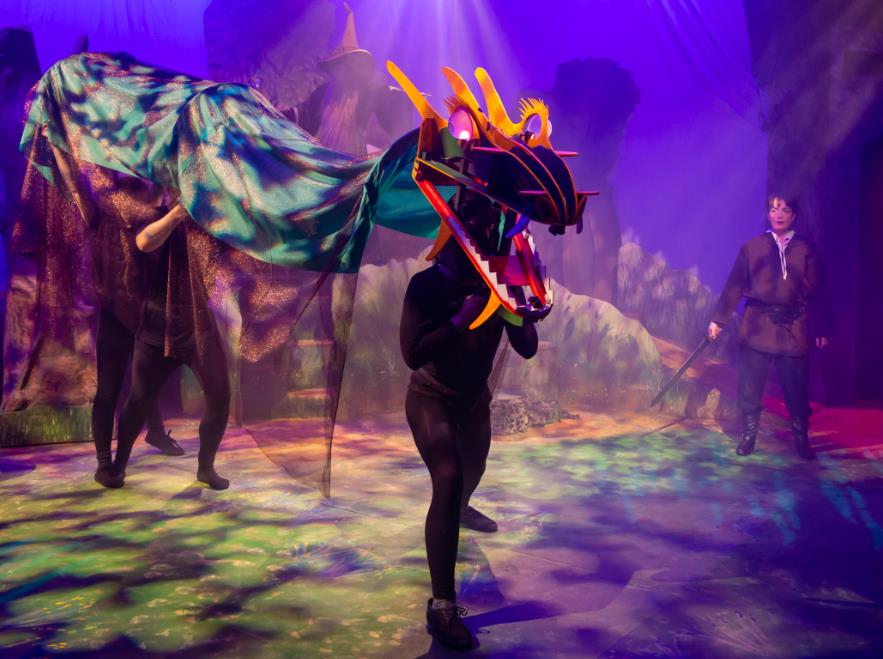
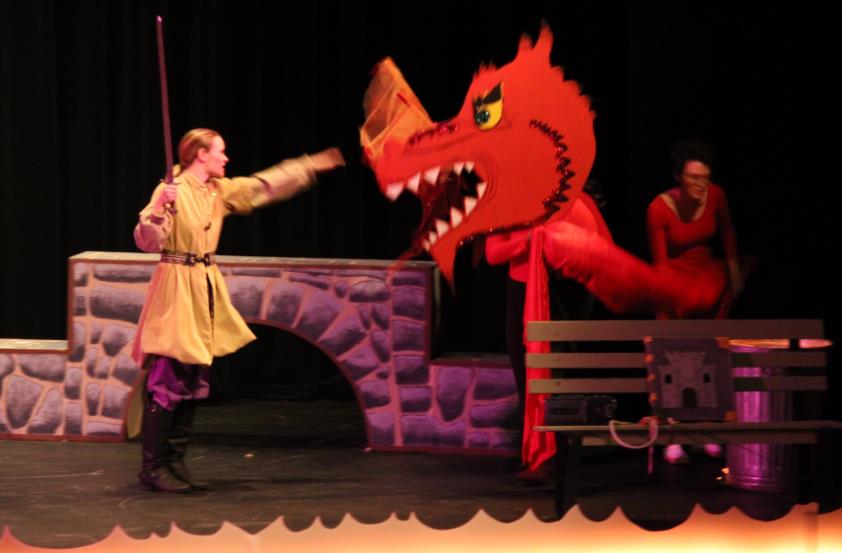
Brentwood
Theatre, UK- Mount
Hood Community College, Gersham OR
In addition to
the creatures of myth and legend, some real reptiles have been called
dragons. They include many species of small lizards found in
Southeast Asia and the East Indies. These lizards belong to the genus
Draco (a name that comes from Greek and Latin words for dragon).
Commonly called flying dragons, these lizards have scaly membranes
between the front and back legs that allow them to glide from tree to
tree. Another kind of lizard called a dragon, the venomous Komodo
dragon (Varanus komodoensis) of Indonesia, is the largest living lizard.

The
Strange History of the Fairy Tale Snow White
Classroom
Material for ArtReach's Play "Snow
White and the Seven Dwarfs"
To
most people, the name Snow White evokes visions of dwarves whistling
as they work, and a wide-eyed, fluttery princess singing,
"Someday my prince will come" - images popularized by the
1937 Disney animated film. Yet the Snow White theme is one of the
darkest and strangest to be found in the fairy tale canon -- a
chilling tale of murderous rivalry, poisoned gifts, blood on snow,
witchcraft, death&ldots;in short, not a tale originally intended for
children's tender ears.
"Someday
my prince will come."
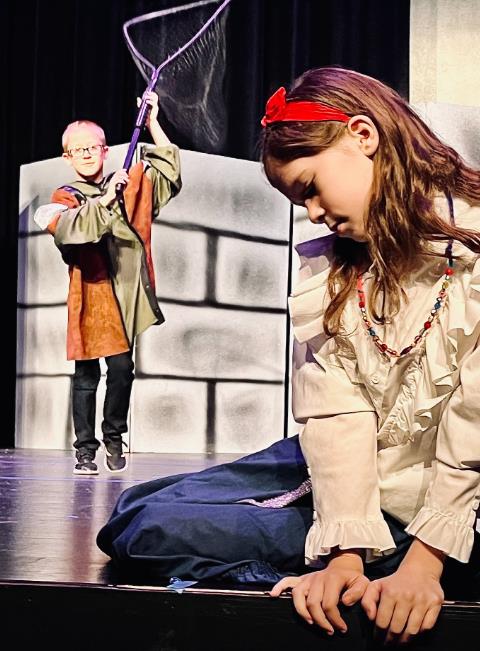

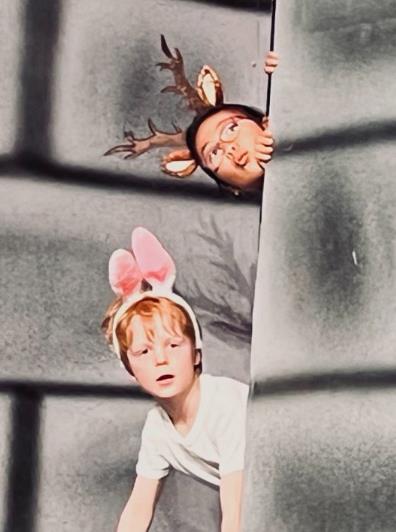
Locally Grown Theatre, Cottage
Grove MIN - ArtReach's
"Snow White"
Disney's
version was based on the German tale popularized by the Brothers
Grimm, originally titled "Snow-drop" and published in
Kinder-und Hausmarchen in 1812. The Grimms' Snow White is a much
darker, chillier story, yet it too had been cleaned up for
publication, edited to emphasize the good Protestant values held by
Jacob and Wilhelm Grimm. Although legend has them roaming the
countryside collecting stories from stout German peasants, in truth
the Grimm brothers acquired most of their tales from a middle-class
circle of friends, who in turn were recounting tales learned from
nurses, governesses, and servants, not all of them German.
Thus
the "German folk tales" published by the Grimms included
those from the oral folk traditions of other countries, and were also
influenced by the literary fairy tales of writers like Straparola,
Basile, D'Aulnoy, and Perrault in Italy and France. Variants of Snow
White were popular around the world long before the Grimms claimed it
for Germany, but their version of the story is the one that most
people know today. Elements from the story can be traced back to the
oldest oral tales of antiquity, but the earliest known written
version was published in Italy in 1634. This version was called The
Young Slave, published in Giambattista Basile's Il Pentamerone, and
is believed to have influenced subsequent retellings - including a
German text published by J. K. Musaus in 1784 and the Grimms' text in 1812.
The
"German folk tales" were published by the Grimms Brothers.
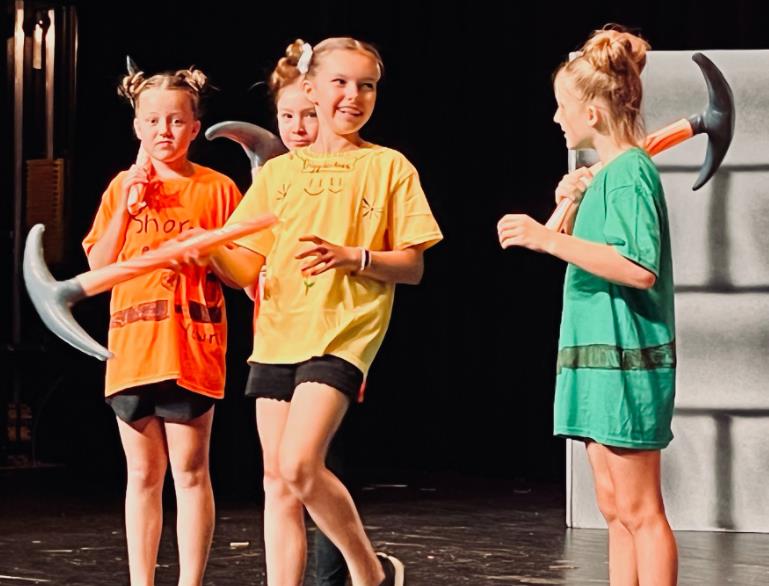

Locally Grown Theatre, Cottage
Grove MIN - ArtReach's
"Snow White"
The
Young Slave contains motifs we recognize not only from Snow White
but also Sleeping Beauty (the fairy's curse), Bluebeard (the locked
room), Beauty and the Beast (the troublesome gift), and other tales.
An aunt-by-marriage plays the villain in this version. In another
Italian tale, The Crystal Casket, the villain is a scheming
stepmother who was also the young girl's teacher! In a third Italian
version of the tale, it's the girl's own mother who wishes her ill -
an innkeeper named Bella Venezia who cannot stand a rival in beauty.
First she imprisons her daughter in a lonely hut by the sea; then she
seduces a kitchen boy and demands that he murder the girl. "Bring
back her eyes and a bottle of her blood," she says, "and
I'll marry you."
In
a Scottish version of the story, a trout in a well takes the role of
the magical mirror on the wall. Each day a queen asks, "Am I not
the loveliest woman in the world?" The trout assures the queen
that she is&ldots; until her daughter comes of age, surpassing the
mother in beauty.
Jacob
and Wilhelm Grimm collected their version from family friends in the
town of Cassel, Germany. This version contained several elements from
the earlier Italian stories, combined with imagery distinct to the
lore of northern Europe. Dwarfs do not appear in the Italian
variants, for instance, as dwarfs play little part in the Italian
folk tradition. The Nordic and Germanic traditions, by contrast,
contain a wealth of magical lore about burly little men who toil
under the earth, associated with gems, iron ore, alchemy, and the
blacksmith's craft. The Grimms' version starts, like so many fairy
tales, with a barren queen who longs for a child. It's a winter's
tale in this northern clime, set in a landscape of vast, icy forests.
The queen stands sewing by an open window. She pricks her finger.
Blood falls on the snow. "Would that I had a child," she
sighs, "as white as snow, as red as blood, and as black as the
wood of the window-frame." Her wish is granted when Snow White
is born, yet the queen's jealousy at her daughter's beauty soon turns
her against the child. Driven out of her home, out of her past, away
from all that is harsh but familiar, Snow White makes her way through
the wilderness to an unknown destination. Her journey begins with the
queen's henchman, the huntsman. He defies his mistress and does not
slay the girl, but he is no true ally, merely a coward. Beauty aids
her once again when she finds the house of the dwarves.
Snow
White makes her way through the wilderness.

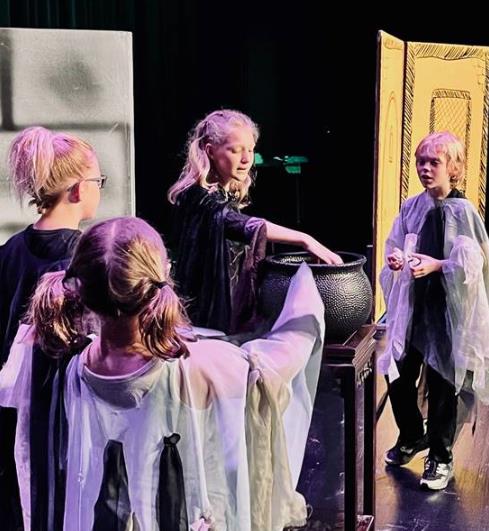
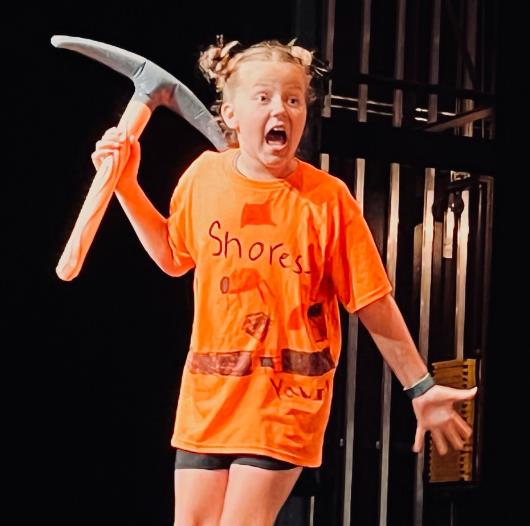
Locally Grown Theatre, Cottage
Grove MIN - ArtReach's
"Snow White"
Soon,
the queen learns that Snow White still lives and determines to kill
her young rival herself. Disguised as an old peddler woman, she sells
the girl poisoned bodice laces, then combs her hair with a poisoned
comb. After each of her visits, the dwarfs return home to find
their young housekeeper dead. The dwarfs can revive her once, even
twice, but with the third act of poisoning, she seems indisputably
dead. Her body, too beautiful to bury, is displayed in a clear glass
casket -- or else on a woodland bier, or a four-poster bed, or a
shrine surrounded by candles. (In other variants, she is thrown into
the sea, abandoned on a doorstep or windowsill, sent to the fairies,
stolen by gypsies, even carried on a reindeer's antlers.) There are
various ways Snow White's spell of death/sleep is broken, but
generally not with a kiss (that seems to be a modern addition). The
poisoned item must be removed, usually by pure accident. In the
chaste Grimms' version of the tale, Snow White's body is handed over
to a prince who happens to be passing by. Struck, as all men in this
tale are struck, by the girl's extraordinary beauty, he swears he
can't live without her. The dwarfs consent. (He's a prince, after
all.) "I will prize her as my dearest possession," the
prince promises the sad little men. As his servants bear the casket
away, one stumbles and the fatal piece of poisoned apple flies from
her mouth. "Oh heavens, where am I?" she cries as she
wakes. "You're with me," he quickly assures the girl. He
declares his love, offers marriage, and promptly spirits the
beautiful maiden away. In the final scene of the Grimms' version, the
queen is invited to Snow White's wedding, then forced to dance in
red-hot shoes until she is dead. It's a scene left out of the Disney
film and most modern children's renditions.
Beloved
by generations of children.
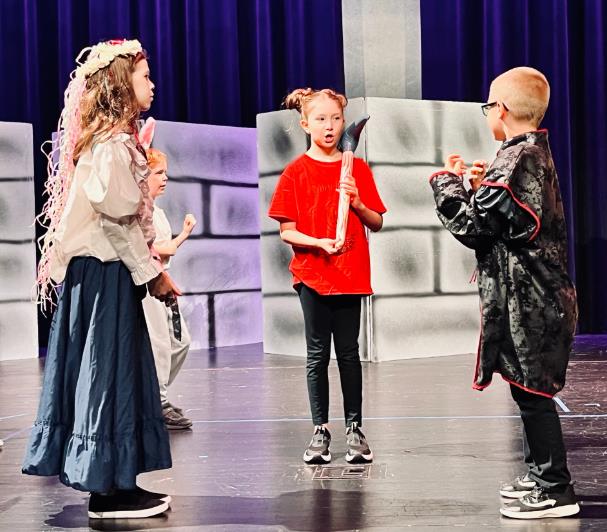
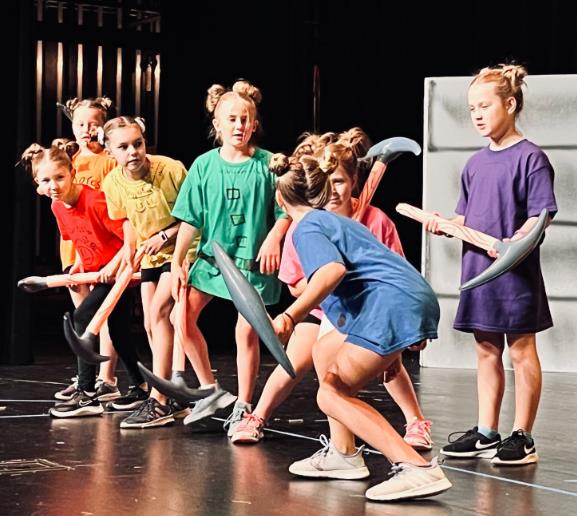
Locally Grown Theatre, Cottage
Grove MIN - ArtReach's
"Snow White"
Walt
Disney made several other significant changes to the Grimms fairy
tale when he chose Snow White as the subject of his very first
full-length animated film. He emphasized the dwarfs, giving them
names, distinct personalities, and a cozy cottage in a sun-dappled
wood full of bluebirds, bunnies, and flowers, not snow. The role of
the prince is greatly expanded, and the square-jawed fellow becomes
pivotal to the story. His love for Snow White, demonstrated at the
very beginning of the Disney film, becomes the spark that sets off
the powder keg of the stepmother's rage.
In
this singing, dancing, whistling animated version, only the queen
retains some of the real power of the traditional tale. She's a
genuinely frightening figure, and far more compelling than little
Snow White, who (drawn as a blonde at one point) is wide-eyed, giddy,
and childish, wearing rags (Cinderella-style) at the start of the
film, downtrodden but plucky. Although the Disney film was a
commercial triumph, beloved by generations of children, critics
through the years have protested the sweeping changes Disney Studios
made, and continues to make, when retelling such tales. Walt Disney
himself responded, "It's just that people now don't want fairy
stories the way they were written. They were too rough. In the end
they'll probably remember the story the way we film it
anyway." Time has proved him all too right. (Study
and analysis by Terri Windling, edited.)

Outline
of ArtReach's Play: Treasure
Island: Young Pirates of the Caribbean
1883
novel by Robert Louis Stevenson, written for young people who
dreamed of adventure on the high seas. This classic book has endured
through the decades as a beloved tale of pirates, ocean voyage and
exotic islands. One boy, Jim Hawkins, is the hero of this
swashbuckling fantasy, adapted with lightness and comedy for young performers.
As
the play begins, Jim Hawkins is an ordinary contemporary boy who
having a very bad day. Everything seems to go wrong at school and
when he comes home his mother has cooked his least favorite food. Mom
tells him that if he does not eat his dinner he will not be allowed
to go trick or treating tonight for Halloween. Jim refuses and is
sent to his room.
Read
the story first to get everyone on the same page!
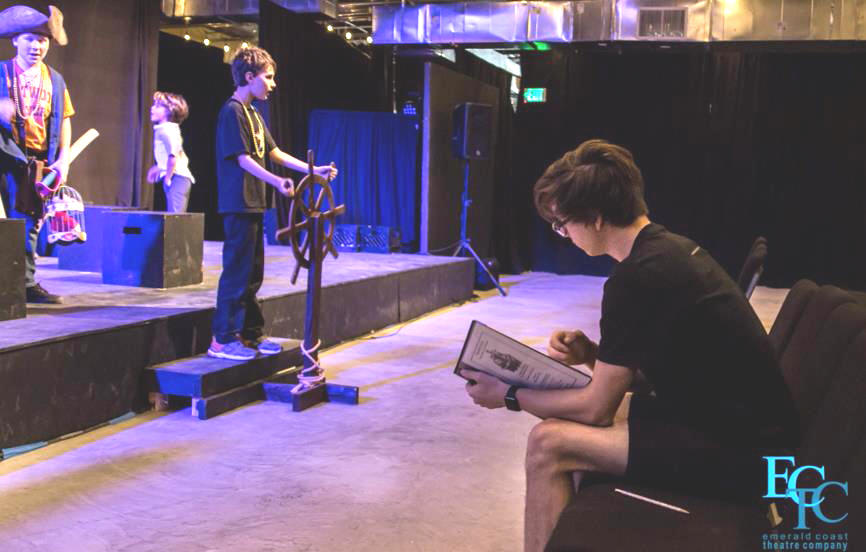
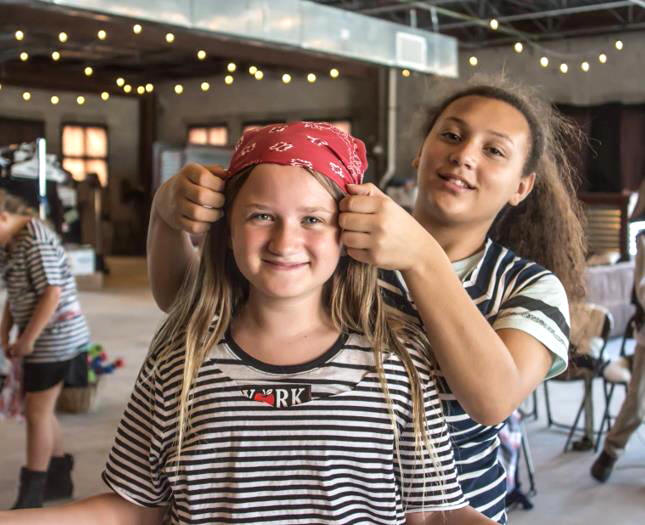
In Rehearsal - Emerald Coast
Theatre Company, Miramar
Beach FL
The
Storytellers of the play seem to hover around Jim like fragments of
his rich imagination. As Jim indulges in a fantasy of pirates and
adventure, his friends the Storytellers take part. When there is a
knock at Jim’s bedroom door, Jim assumes it is his mother. But
when he opens the door he is confronted with a nightmare of a pirate,
Billy Bones.
Somehow
Jim has been swept into the classic story! Billy Bones storms in as
if he has just arrived at the Benbow Inn and orders Jim to carry in
his sea chest. Bones rails and warns Jim to beware of “the
one-legged man”. Another pirate, Blind Pew, arrives to deliver a
terrible omen to Billy Bones -- the black spot. The black spot is
nothing more than a piece of palm-sized paper with a spot inked on
it, but pirates know it means they have been marked by their comrades
as traitors. The black spot frightens Billy Bones so much that he
clasps his chest and falls to the floor. Billy Bones dies comically,
leaving Jim utterly astonished.
"Blind
Pew delivers a terrible omen -- the black spot."

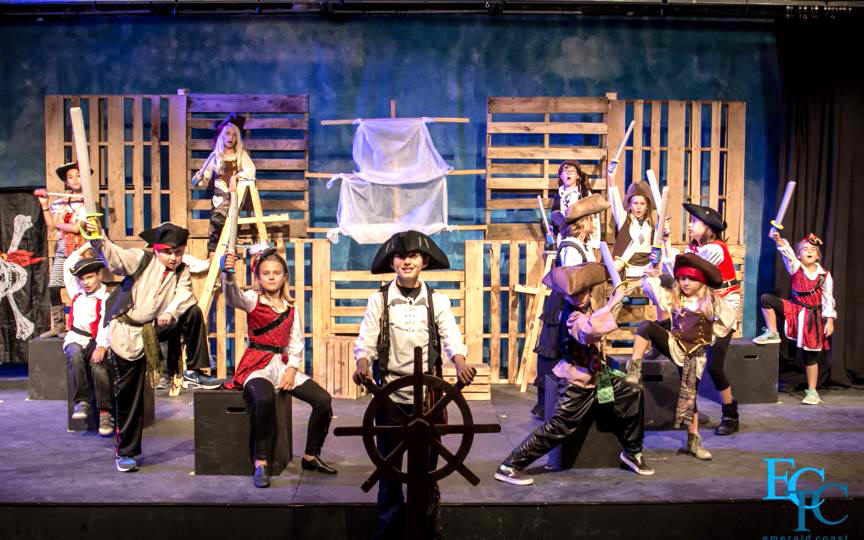
Emerald Coast Theatre Company, Miramar
Beach FL -
ArtReach's Treasure Island
When
Jim looks inside the sea chest he finds a treasure map. Doctor
Livesey and Squire Trelawney call out from the audience and rush
onstage to help with the medical emergency. They recognize the map --
it belonged to Captain Flint who disappeared three years ago. They
take charge of the situation, calling for an immediate voyage to the
Caribbean. Jim is swept up in their plans and soon they are in the
Squire’s carriage headed for the harbor and a ship called the Hispaniola.
The
sailors and crew climb aboard the Hispaniola singing, delighted with
the prospect of a voyage at sea. The one-legged ship’s cook,
Long John Silver, enters with his parrot in a cage. Captain Smollett
calls the roll and we are introduced to several colorful members of
the crew. As the ship casts off from the shore, Jim is thrilled to
see his long dreamed of adventure finally take shape.
"Jim
is thrilled, his adventure finally takes shape."

Emerald Coast Theatre Company -
ArtReach's Treasure Island
Jim’s
fun turns to fear when Long John Silver tells him that every man on
board is looking for the treasure map. Jim keeps it close to his
chest and realizes he is in danger. When members of the crew begin a
spirited talk of mutiny, Jim climbs in an apple barrel and hears the
whole conversation. Long John Silver is really a pirate who convinces
the others to take over the ship and claim the treasure for themselves.
Skeleton
Island is in sight as Jim rushes to tell the Captain of the planned
mutiny. The loyal crew members are badly outnumbered and fear for the
worst but Jim has a plan to save the treasure and their lives. Jim
and Honest Abe hop in a landing boat and row to shore before the
pirates can get there.
On
the island Jim and Abe encounter a tribe of natives who serve a man
known as Ben Gunn. Ben Gunn is a pirate that has been marooned on the
island ever since Captain Flint reached it three years ago.
Ironically, Ben Gunn -- who loves only cheese -- found the treasure
years ago and has no use for it. The natives are desperate to get rid
of the pirate and happily give all the treasure to Jim if it means
they will take Ben Gunn away.
"X
marks the spot, but the treasure has already been dug up."
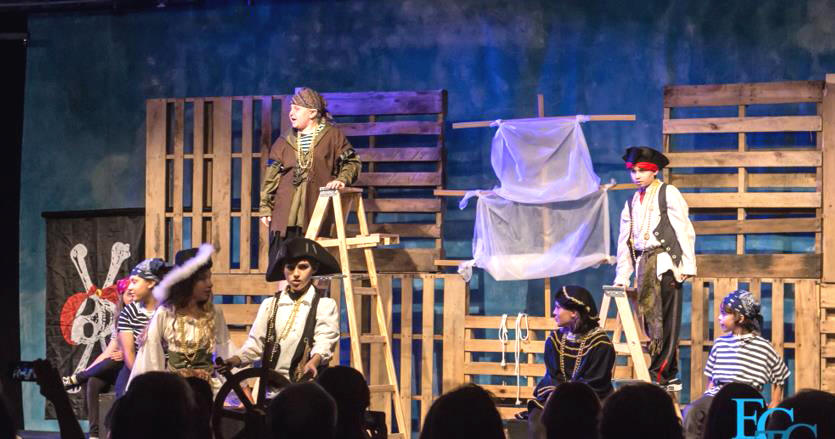
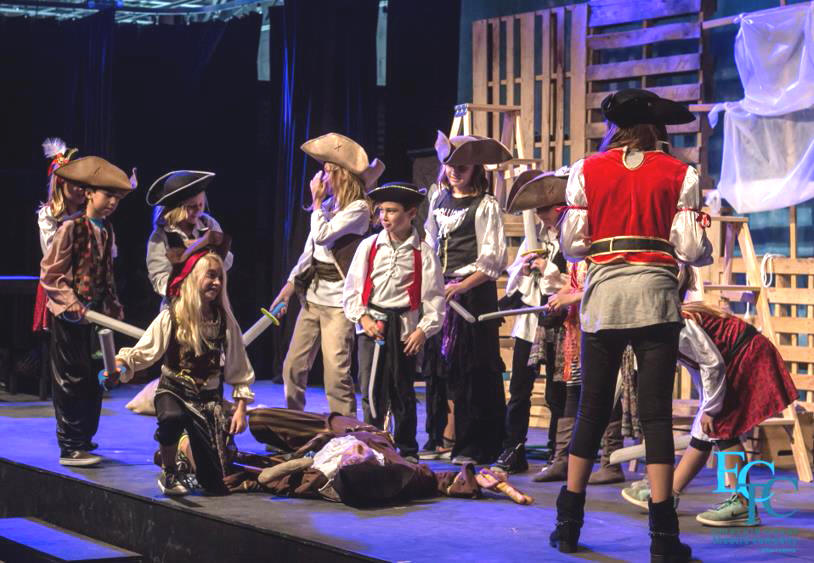
Emerald Coast Theatre Company, Miramar
Beach FL -
ArtReach's Treasure Island
On
his way back to the ship Jim happens on Long John and the pirates
who have captured the Captain and others. Jim offers to give Long
John the map in exchange for their freedom and even offers to go with
them to where the treasure is buried. But when they reach the place
where X marks the spot, the treasure has already been dug up. Jim
escapes and the disappointed, angry pirates give Long John the black
spot. Long John clasps his chest and dies. When the pirates leave,
Long John comes back to life and laughs at his hoax.
Jim
makes his way back to the Hispaniola where the loyal crew members
are set to take off for home, leaving the pirates marooned on the
island. Just before they push off Long John Silver appears and asks
Jim to take the parrot with him. Jim tells Long John that he is a
very bad man but a very good pirate. Long John tells Jim that pirates
are like dreams because they live forever.
"We're
Pirates!"

Emerald Coast Theatre Company, Miramar
Beach FL -
ArtReach's Treasure Island
As
the ship sails away, Jim finds himself back at home in his room with
the parrot in the cage. His mother knocks on the door and offers him
a bowl of mac and cheese. He can hardly believe that he went so far
away and came back home, returning to his ordinary life. The kids are
outside his window calling for him to go trick or treating. With
Mom’s permission, Jim joins them. Surprisingly, all the kids are
dressed as the characters in his adventure. Jim and the kids set off
for a night of fun -- just ordinary kids enjoying their dreams.

Themes
to Look for in Washington Irving's Story
Discussing
American Literature on Stage, ArtReach's The Legend of Sleepy Hollow
Greed
and Gluttony:
Ichabod wants it all. The money, the girl and the food.
OPINION:
Why do you think Irving chose greed to be one of Ichabod's strongest
character traits? Why not sloth or lust or some other fun deadly sin?
OBSERVATION:
Does anyone else in the story strike you as greedy, or does Ichabod
stand out in this way?
OPTIONS:
How would the story change if Ichabod got the girl? What commentary
would that outcome say about greed?
HYPOTHETICAL:
What would the story have looked like if Ichabod suffered from
another one of the seven deadly sins? Pick one and explore.
"Is
'The Legend of Sleepy Hollow' a proper ghost story?"

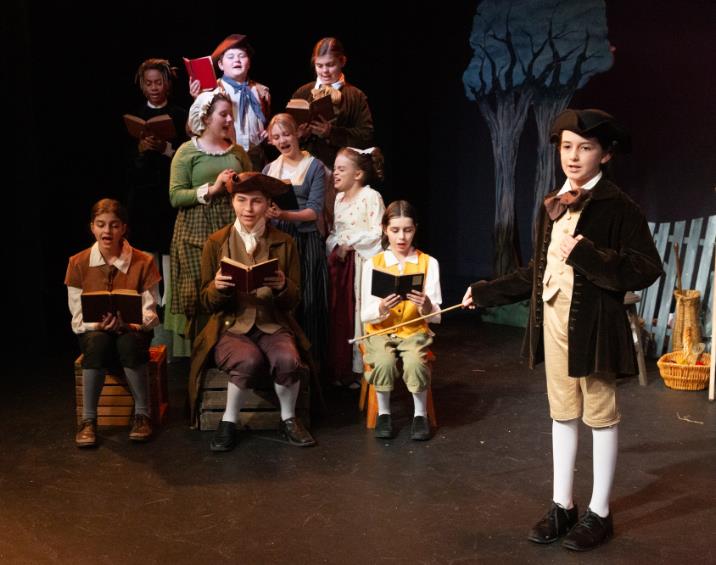
ArtReach's The
Legend of Sleepy Hollow - New England
Youth Theatre, Brattleboro, VT
Ghost
Stories: Magic or Pretend?
OPINION:
Is The Legend of Sleepy Hollow a proper ghost story or simply an
old-wives tale? Back up your claim.
OBSERVATION:
There are differing accounts as to what happened to Ichabod Crane.
What evidence is there that Ichabod's disappearance was Supernatural?
What evidence is there that Ichabod's disappearance was not supernatural?
OPTIONS:
The Headless Horseman haunts Sleepy Hollow because he died during
the American Revolutionary War. What kind of ghost would haunt a
modern day Sleepy Hollow? Why?
HYPOTHETICAL:
If you were a ghost who and where would you haunt? Why? What would
be your trademark spook?
"If
you were a ghost who and where would you haunt?"
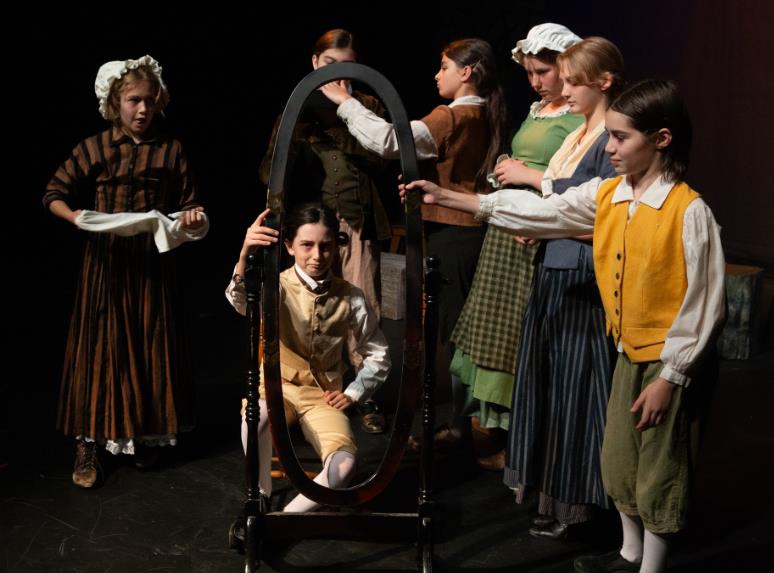
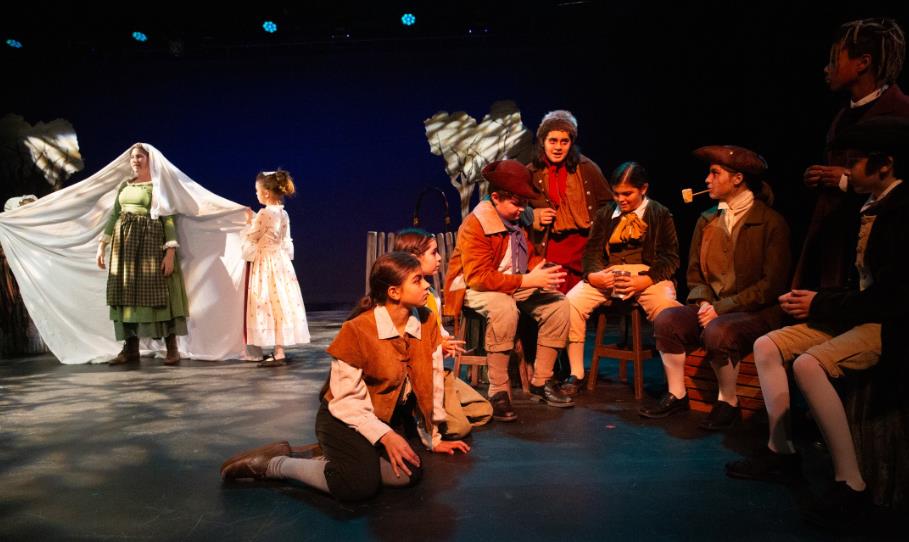
ArtReach's The
Legend of Sleepy Hollow - New England
Youth Theatre, Brattleboro, VT
Truth:
Fact or Fiction? You Decide
OPINION:
Do you trust the narrator? Why? Or why not? Why do you think Irving
wrote the narrator to be this way?
OBSERVATION:
Who decides what the truth is in the Sleepy Hollow community? What
is their role in the society of Sleepy Hollow and why do you
speculate they have this power?
OPTIONS:
How would the story change if we knew for a fact that the events of
the final haunting were 100% real? Adversely, what would change if we
knew without a doubt that those events were absolutely fake?
"Why
do you think Irving wrote the narrator to be this way?"

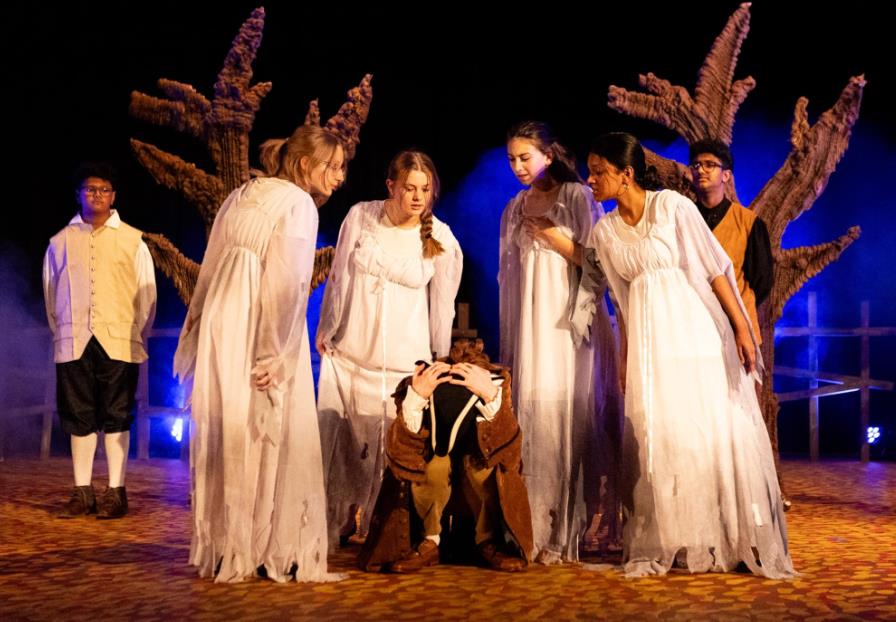
ArtReach's The
Legend of Sleepy Hollow - Coppell High School Cowboy Theatre, TX
HYPOTHETICAL:
There is an old Chinese proverb that recounts: "There are three
truths: my truth, your truth and the truth." Pick a truth:
Ichabod, Katrina or Brom! Choose a pivotal moment in the story and
write or debate in class on Ichabod, Katrina or Brom's side of the story.

Interesting
Facts About Winnie-the-Pooh
Did
you know? Fun stuff to think about before performance.
Winnie-the-Pooh
is based on a real, young bear. Before Winnie-the-Pooh, there was
another bear, a real bear named Winnie – and she was a girl.
In
1914, Lieutenant Harry Colebourn, a Canadian soldier and
veterinarian on his way to tend horses in World War I, followed his
heart and rescued a baby bear. He named her Winnie, after his
hometown of Winnipeg, and he took the bear to war.
"Milne’s
son Christopher Robin fell in love with the bear."
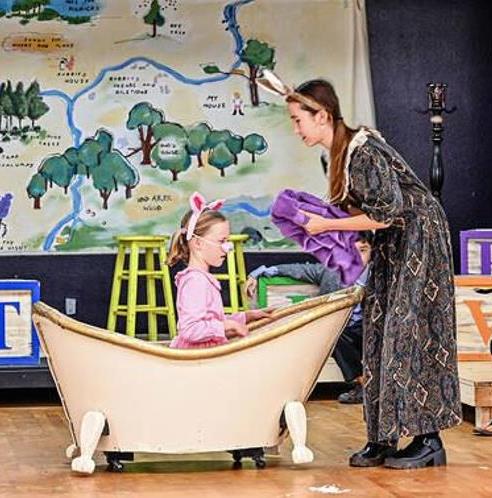

ArtReach's Winnie-the-Pooh
- Island School, Lihue HI
The
black bear cub was purchased from a hunter by Colebourn during the
War, becoming his pet and the troop’s mascot, before later
residing in the London Zoological Gardens. The cub was named
Winnipeg, or Winnie, for short. It was here in London that
Milne’s son Christopher Robin fell in love with the bear, naming
his own toy teddy bear after the little black bear.
Christopher
used to play with swans, and he named one Pooh, to paraphrase,
“As it is a fine name to call, and if she doesn’t come, you
at least get to say, Pooh.”
Christopher
originally named the toy, Edward Bear, but inspired by Winnipeg and
the swans, renamed it Winnie-the-Pooh. And to justify giving his male
bear a female name, rebutted, “His name isn’t Winnie,
it’s Winnie-the-Pooh.” The name stuck, books were written,
characters were drawn – and the rest is history.
Originally,
Milne was reluctant to hire E. H. Shepard to illustrate. Although
Ernest Shepard was introduced to Milne through their mutual
colleague, E.V. Lucas, Milne was reluctant to hire Shepard due to his
political cartoonist background. Despite this, Shepard took it upon
himself to wander through Ashdown Forest – the inspiration of
the Hundred Acre Wood – to create a portfolio of sketches.
Presenting them to Milne after appearing at Milne’s home
unannounced, he won Milne’s heart and soon after the hearts of
children across the world.
The
real Christopher Robin was left with ‘nothing but empty
fame’. The real Christopher Robin, as a young man, sadly,
resented his father using his name in the popular books, becoming
forever famed ‘as the tender little boy in the Hundred Acre
Wood’. Becoming a writer himself, Christopher Robin wrote
memoirs of his own life including The Enchanted Places, Beyond the
World of Pooh and The Hollow On The Hill where he announced that
“it seemed to me almost that my father had got where he was by
climbing on my infant shoulders, that he had filched from me my good
name and left me nothing but empty fame.”
"Shepard
wandered the inspiration for Hundred Acre Wood."
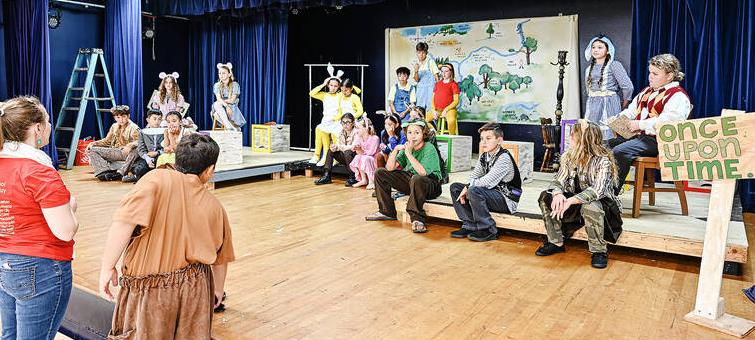

ArtReach's Winnie-the-Pooh
- Island School, Lihue HI
Winnie-the-Pooh
has been translated into over 50 different languages. Gaining
worldwide popularity, Winnie-the-Pooh has been translated into more
than 50 different languages, including Afrikaans, Esperanto and
Yiddish. The most successful translation and unexpected hit is the
Latin version, Winnie Ille Pu (1958), by Hungarian doctor Alexander
Lenard. One critic described this book as “‘the greatest
book a dead language has ever known,” and in 1960, it became the
first foreign-language book -- and only Latin book -- to be featured
on the New York Times Best Seller List.
The
Russians created their own portrayal of Winnie-the-Pooh. Although we
all love to see Pooh wandering through the woods, helping his
friends, there’s something oddly satisfying about watching the
Russian animation portrayal of Winnie. Closely following the original
trilogy, the look of Winnie is very different from Shepard’s
illustrations, however, just as cheery.
Pooh
has inspired the names of two streets in Europe. Being super popular
in Poland, a street in Warsaw is named after this friendly little
bear, named ‘Ulica Kubusia Puchatka’. This 149-metre-long
street gained its name in 1954 by readers who entered a competition
in Express Wieczorny. There is also a street in Budapest,
Micimackó utca, named after him.
Only
16 fictional characters have stars on the Hollywood Walk of Fame.
And one of them is Winnie-the-Pooh! Receiving his own star in April
2006, not only did he become one of the very few fictional characters
– alongside Mickey Mouse, Big Bird, Kermit the Frog and Bugs
Bunny – to be awarded, but Pooh is also the only bear ever to be honoured.
Today,
Shepard’s illustrations are ‘worth their weight in
gold’. In December 2014, an original E. H. Shepard illustration
featuring Christopher Robin, Pooh and Piglet sold for £314,500
($431,000) at Sotheby’s. This was the highest price to date that
one of these drawings had been purchased.
Winnie-the-Pooh
has a star on the Hollywood Walk of Fame!
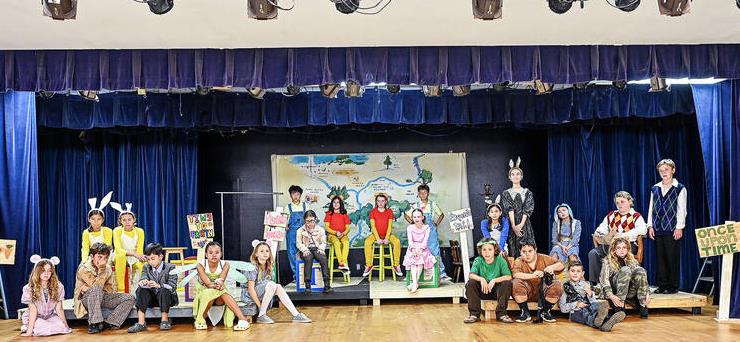
ArtReach's Winnie-the-Pooh
- Island School, Lihue HI

The
Little Mermaid story has many versions
Classroom
Discussion
The
original story of The
Little Mermaid is different from the many versions we have
today. In Hans Christian Andersen's story, the Little Mermaid
is the youngest of six princesses in the parallel universe of the
undersea kingdom. When they are old enough, mermaids get to go to the
surface to see the land, and all the princesses are curious about it,
but the Little Mermaid is the most curious of all. When she goes to
the surface, she sees the prince, and falls in love with him. She
saves his life (though he doesn't realize it until the end), and
decides that she wants to marry him. She goes to a witch in her
watery world to ask to be made into a human being. The witch agrees,
but tells the Little Mermaid that it will be terribly painful, and
also that she will have to pay for it with her beautiful voice. In
addition, she will only be able to remain human if the prince loves
her and marries her. The morning after he marries someone else, she
will become foam on the waves - essentially, she'll die.
"She
goes to a witch to ask to be made a human being."
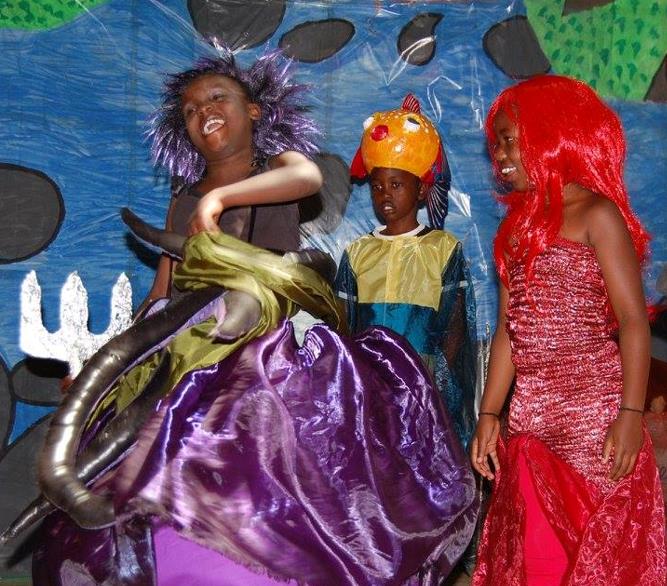

ArtReach's The
Little Mermaid - Nairobi Academy, Kenya
The
Little Mermaid agrees. She becomes human, meets the prince, and
charms him with her dancing and her expressive eyes, but he marries
someone else. The Little Mermaid's sisters arrive, having struck a
deal with the sea witch, and try to get her to save herself by
killing the prince. She has the choice of stabbing the prince and
letting his blood wash over her legs, at which point she would return
to her mermaid state, or allowing herself to die. She dies and goes
to heaven.
"Is
the Mermaid an admirable heroine?"
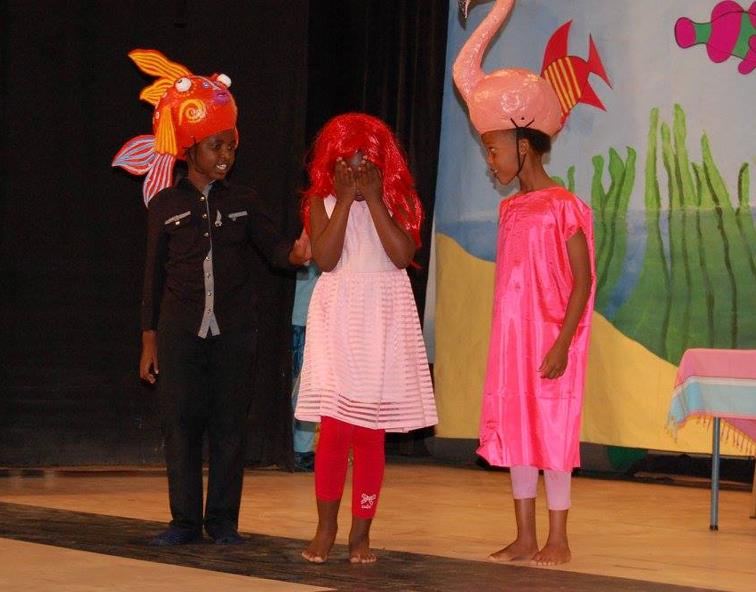

ArtReach's The
Little Mermaid - Nairobi Academy, Kenya
Compare
the Little Mermaid with other fairy tale heroines you've studied and
performed such as Mulan and Sleeping beauty. She exhibits curiosity,
boldness, and initiative, even if she doesn't succeed in her plans.
Her sisters, also, take the initiative to try and rescue her, though
they don't succeed. Does this make her more admirable than a heroine
such as Cinderella or Snow white? Discuss.

Guide
to the Obon Festival in Japan
Background Info
for "A Thousand Cranes"
School Play
The Obon festival (also known
as Bon festival) is an annual Japanese holiday which commemorates and
remembers deceased ancestors. It is believed that their spirits
return at this time to visit their relatives.
Chochin (paper) lanterns are
hung to guide the spirits and Obon dances (bon odori) are performed.
Families have reunions and visit the graves of their relatives and
make food offerings at altars and temples.
"The
Buddhist festival has been celebrated for more than 500 years."

ArtReach's A
Thousand Cranes - Bland County High School, Rocky Gap VA
It is observed from the 13th
to the 15th day of the 7th month. However, according to the solar
calendar the 7th month is July but according to the lunar calendar,
the 7th month is August. Obon is therefore celebrated at different
times in different regions depending on which calendar is observed.
The official 2019 dates are
August 13-15 though it will be celebrated between July 13-15 in some
places. The Obon week in mid-August is one of Japan's three major
holiday seasons making it one of the busiest times of the year for
traveling. Many Japanese people will leave their cities around August
10 and come back on August 17-18.
Obon
traditions and celebrations
On the first day of Obon,
people take the chochin lanterns to the graves of their families.
They call their ancestors' spirits back home in a ritual called
mukae-bon. In some regions, huge fires are lit at the entrances of
houses to guide the spirits to enter.
At the end of the Obon
festival, families help their ancestors' spirits return back to the
grave by guiding them with their chochin lanterns. The ritual is
called okuri-bon. Again, the ritual varies slightly between different
regions of Japan.
In recent years, floating
lanterns (toro nagashi) have gained in popularity. The beautiful
lanterns float down a river that runs to the sea to symbolically send
their ancestors' spirits into the sky.
The style of the traditional
Bon Odori dance varies from region to region but it is normally based
around the rhythms of Japanese taiko drums. Dancers perform on a
yagura stage and participants wear light cotton kimonos. Anyone can
join in the dances which are held in parks, temples, and other public
places around Japan.
"Joy
is the origin of the Obon dance."


ArtReach's A
Thousand Cranes - Bland County High School, Rocky Gap VA
Obon
festivals in Japan
There are a number of special
Obon festivals which tourists can visit using their JR Pass. The
Daimonji Festival in Kyoto is probably the most famous. A series of
spectacular, 200m-long, character-shaped bonfires are built on
mountainsides which are visible throughout the city. Each one is then
individually set on fire.
For those who love to dance,
the Gujo Odori Festival In Gujo, (Gifu prefecture) is a week-long
party where dancers perform each night from 8 pm until 5 in the
morning. Over 1.3 million tourists go there each year.
At the other end of the
spectrum, if you're looking for a small festival which has preserved
ancient traditions, there is the Hokkai Bon Odori. It is also the
birthplace of one of the most famous Japanese traditional songs.
The
origins of Obon
The Buddhist festival has been
celebrated for more than 500 years. It originates from the story of
Maha Maudgalyayana (Mokuren). He was a disciple of Buddha who used
his powers to see the spirit of his deceased mother. He discovered
she had fallen into the Realm of Hungry Ghosts and was suffering.
Buddha advised Mokuren to make
offerings to Buddhist monks. On the 15th day of the 7th month, he
followed Buddha's advice and his mother was released from her
suffering. Mokuren danced with joy which is the origin of the Obon dance.
The Japan Rail Pass
Let's
Talk about Amelia Earhart!
Discussions
for
ArtReach's Amelia Earhart
Play for Young Audiences
From Study
Guide: The Little Company, Morehead State University, 106 Baird Music
Hall, Morehead, KY 40351
What
Happened? Many intriguing and often entertaining
conspiracy theories and speculations were made about Amelia Earhart's
famous disappearance. Not only were the factors regarding the actual
cause of the failed flight in question, but also the reason why her
remains were never found. People have guessed at everything from her
creating the whole expedition as a ruse to escape her marriage to
Putnam, to the idea that she and Noonan crashed on a remote island in
the Pacific Ocean and enormous coconut crabs hid her remains in their
dwell-ings. For this activity, write your own conclusion about what
really happened when she disappeared with her navigator Fred Noonan
on their iconic voyage around the world.
"People
have guessed:
What happened, Amelia?"



Amelia
Earhart - Barter Theatre, Abington VA
Where
Is Amelia? Amelia Earhart's life could be
described as one long and tireless journey. For this activity, design
a destination for Amelia Earhart. Feel free to interpret this as
creatively as you wish; is she in Ireland amongst the cows, or
perhaps on a lonely island with the coconut crabs? Keep in mind the
adventures Earhart encountered in her lifetime as well as the
important people she met along the way.
Sensationalism:
In the play, the author uses the Great Depression and the suffering
of the American people to convey a theme of desperation. She then
displays how the media honed in on Amelia's activities to distract
citizens from the issues the country was facing. In today's society
we have similar scenarios of media distractions. Name as many
instances as you can in which a great tragedy or period of suffering
has been dulled by the media with a flush of superficial news-worthy
events in pop culture. As a few examples, marriages between popular
celebrities, issues within foreign countries, political events,
controversies, and anything in the media that catches the attention
of the public audience.
Where
does
ArtReach's Cinderella come
from? Folk Tales become Fairy Tales for Children
Cinderella stories are
considered by many to be folk tales (fairy tales, folklore). A folk
tale is a legend or story handed down from generation to generation,
usually by oral retelling. Folk tales often explain something that
happens in nature or to express a truth about life, such as a lesson
to be learned. Many folk tales were written for adults, but now are
enjoyed by nearly everyone, especially children. Folk tales
appealing to children are generally called fairy tales.
Kids
Perform ArtReach's Cinderella for Summer
Camp
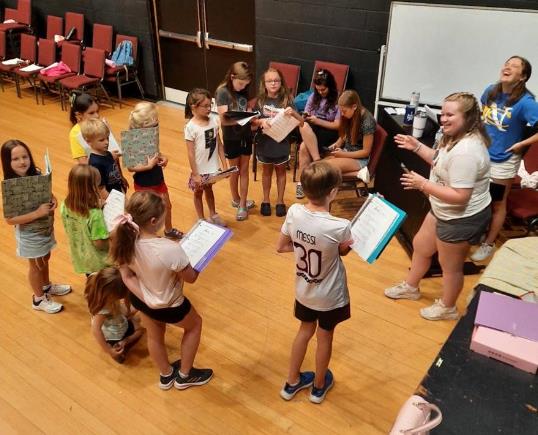

ArtReach's Cinderella
- Newport Central Catholic Youth Drama Camp, Newport KY
Most fairy tales include:
• A beginning which
starts with, "Once upon a time...".
• A kind character (who
is usually treated badly)
• A wicked character
• Enchantment (magic)
• Some form of royalty
• Goodness rewarded in
the end
• The story ending with,
"...they lived happily ever after."
Cinderella is one of the
best-known fairy tales known round the world. The themes from the
tale appear in many similar stories in a variety of cultures. There
are literally hundreds of versions.
"One
of the best-known fairy tales known round the world."


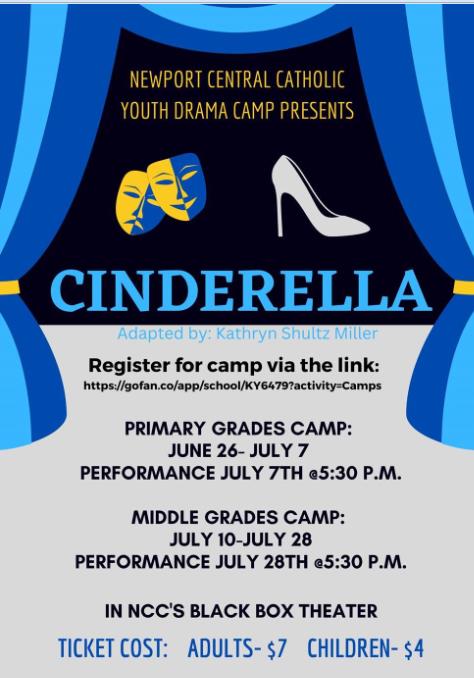
ArtReach's Cinderella
- Newport Central Catholic Youth Drama Camp, Newport KY
The tale always centers around
a kind heroine (Cinderella) who is treated badly (Stepmother,
Stepsisters) after the death of her mother. The father is either
absent or neglectful depending upon the story. A magical person
(Fairy Godmother) and/or item (Pumpkin Coach) usually helps the
heroine prevail and achieve her greatest wish (marry the Prince) at
the end of the story. Usually these tales include an enlightenment
touched off by an article of clothing (in most cases a shoe) that
causes the heroine to be recognized (the shoe fits only Cinderella)
for her true kindness.
Of the many versions of the
tale – many you’ve heard, maybe a few you didn't know
existed – the most well-known is, by far, the classic Cinderella.
Synopsis
of ArtReach's Musical Play: Twas
the Night Before Christmas
Read and
Discuss before Viewing or Performing
“My
idea of Christmas, whether old-fashioned or modern, is very simple:
loving others. Come to think of it, why do we have to wait for
Christmas to do that?”
–
Bob Hope
“'Twas
the Night Before Christmas' is a fun-filled romp through a
heart-warming tale of family love and playful friendship. Hop a ride
with Izzy on the Christmas Train to the North Pole and hold onto your
hat! Anything can happen when Izzy’s around.
The
play begins with the magical zing of a Christmas snow as the Clement
Moorefamily prepare for Christmas. It seems everyone in town has come
out to carol asthe audience becomes the carolers with a hearty round
of the favorite song, Deck the Halls. The children, Clara, Willy and
Bo, implore Mother and Papa (Clement) to join the fun. But Clement is
a bit out of sorts; he has a poem to finish for Christmas publication
and it still isn’t done!
Snips
and snippets of rhyme fill Clement’s head as he tries to finish
his poem. The children are hanging their stockings by the chimney
with care! Mother tells the children to go off and get all snug their
beds! Little by little the words gather a storm in Clement’s
head. At last he writes the line: Not a creature was stirring not
even a&ldots;
“Mouse!”
Mother calls and sure enough there is a mouse in the house. It is
the children’s pet mouse Izzy. Only Izzy has grown tremendously
over the last few days, the size of a human child – and he talks
too. This is too much for Mother who argues it is not sanitary to
have a rodent living among children. Poor Izzy is set
“free”, all alone on the street for Christmas Eve.
Izzy
is approached by a surly cop who tells him to move along. Izzy sings
his heart out but to no avail. All seems hopeless until he meets up
with a shady character named Louie. Louie’s got some hot news
– it seems Santa is hiring and needs mice just like Izzy to help
out. Convinced this is stroke of luck, Izzy climbs aboard Louie’s
train and takes off for the North Pole. “Look out Santa here I
come!” he cries.
"A
fun-filled romp through a heart-warming tale of family love."


ArtReach's Twas
the Night Before Christmas - Fort Scott High School, Fort Scott KS
Meanwhile in
Santa’s Workshop the Elves are working overtime to meet the need
for increased production – trying to make sure there are enough
toys for every good little girl and boy. But Knuckles, the foreman,
tells them it is not enough. What is worse, many of the toys are
defective, “scratch and dents”.
Knuckles throws
the bad toys out the window. And who should be there to catch them?
Rosie the Christmas Reindeer.
Rosie is much
maligned in the North Pole for her rosie, shiny nose. While all the
other reindeer get ready to fly Santa’s sleigh for Christmas
Eve, Rosie has been recruited by Knuckles to deliver all the bad toys
to the train. Where they go she dare not ask. When Izzy shows up it
seems they have something in common. People just don’t seem to
like talking mice or red nosed reindeer. They decide to become
friends. Izzy learns about the broken toys and decides to help Rosie
get to the bottom of this underhanded business.
Santa’s
famous reindeer play their reindeer games oblivious to the fact that
Santa is quite worried that there aren’t enough toys. Santa
tells Mrs. Claus of his fears but she reassures him that every year
he worries and every year it turns out just fine.
Santa tries to
believe her but still has his doubts.
"Santa
is quite worried that there aren’t enough toys."


ArtReach's Twas
the Night Before Christmas - Fort Scott High School, Fort Scott KS
Izzy and Rosie
sneak a ride on the Christmas Train and find that the track leads
straight to the home of the Abominable Snowman! The Abominable
Snowman hates Christmas and it turns out Louie and Knuckles are part
of his sinister plan to ruin it for everyone!
Rosie and Izzy
try to hide from him but the red light from Rosie’s nose gives
them away. They hide as best they can (with audience shielding them)
until at last the nasty Snowman has them in his grip. Louie helps
cart the hapless friends to the Snowman’s dungeon. “How
long do we have to stay here?” Izzy asks. “Just until
Christmas is ruined!” he is told.
In the dungeon
are all the poor broken toys. Chatty Cathy, the Toy Soldier who
marches backwards and the sad blob of Play-Doh who can never be
anything until a child plays with him. All the toys need is some
loving care and mechanical adjustments. Certainly there are many
children who would love to find them under their trees on Christmas
morning! Everyone wishes Santa were there.
Back at the
North Pole the Elves and the Reindeer have found their courage to
tell Santa of the terrible plot to ruin Christmas. Santa and the
Reindeer fly to the land of Broken Toys to free the Toys, Rosie and
Izzy! Rescued at last, off they go leaving Louie and the Snowman to
wonder what has gone wrong with their best laid plans.
The Abominable
Snowman tears his hair and cries “You were supposed to ruin
everything!” Louie runs away as the furious Snowman chases him off.
But back at the
home of the Moore family, it is Christmas morning and all is happy
and bright! The children awake to find lots of presents under the
tree, and papa snoring nearby. Papa admits he couldn’t sleep and
has been up all night finishing his poem. Mother and the children
implore him to read it to them. They invite the carolers, some of the
children in the audience, to join in the fun as Clement reads.
"It
is Christmas morning and all is happy and bright!"


ArtReach's Twas
the Night Before Christmas - Fort Scott High School, Fort Scott KS
‘Twas the
night before Christmas&ldots;” the poem begins. As the story
unfolds, we discover that “the house” in the story belongs
to the Moores and Izzy leads Santa right to their chimney! Thanks to
Izzy, Clara, Willy and Bo are guaranteed the best Christmas ever.
How could Papa
have created a poem so magical? Why, it perfectly captures
everyone’s dream of a wonderful Christmas! When it is over the
children beg to open their presents: the Chatty Cathy doll, the Toy
Soldier who marches backwards and best of all the blob of Play-Doh
who can finally become something in the children’s hands.
When the poem
is done Izzy appears! The children have missed him so much!
Even Mother is
glad to see him. “Can he stay, Mother?” they ask.
“Yes”, she says and at last Izzy has the family he wished
for. Izzy asks Rosie to stay with him, but she has other plans. Santa
has asked her to guide his sleigh next Christmas! It is a great honor
and she has only one year to get in shape. They have become the best
of friends but now it’s time go their separate ways. Sad to see
her go, but proud of her just the same, Izzy says goodbye.
The Reindeer
call to Rosie, as all the characters and the audience cheer her onto
her next adventure! Hip-hip hooray!